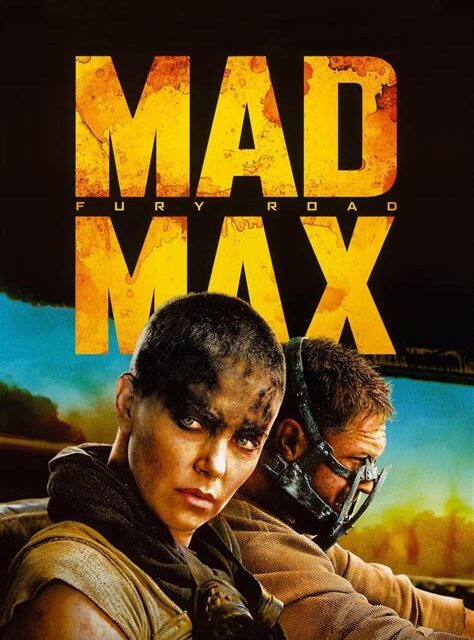I would never see a film such as “Mad Max: Fury Road,” but was persuaded by its ratings: 98% on Rotten Tomatoes, 89% on Metacritic, and 8.7 user rating on IMDB.com. These useful guides have rarely misled me but in this case must wonder how so many good critics could be so wrong.
Perhaps they were being nice to leading lady, Charlize Theron, who manages to retain her dignity in spite of being stuck with a leaden Tom Hardy, who needs to suck in his neck during profile shots, and about four pages of sophomoric dialogue.
Reams of dialogue pages, of course, are not necessary to make a good movie, but given the narrative mess and visual pandemonium of director George Miller’s return to “Mad Max” after 30 years, one hopes for an Anthony Hopkins, Michael Caine, or James Earl Jones to suddenly walk out of cave and say something intelligent.
The viewer, presumably, is supposed to get chill bumps when “Max” finally reveals his name to the badly wounded Imperator Furiosa (Theron), but by then I was grateful that Hardy had kept his mouth shut. Has there been worse performance by a lead actor in a major motion picture recently? I counted two, maybe three expressions on Hardy’s face — fear, anger, and one insipid smile at the pre-Raphaelite nymphets he is helping to save from further impregnation by Immortan Joe (Hugh Keays-Byrne).
Having lost his bevy of underage sex slaves, Immortan Joe leads his small army of reconstituted motor vehicles out of the “Citiadel” into the desert to reclaim them, especially the one about to give birth. Imperator Furiosa, who was herself stolen as a child and brought to the Citadel, leaves him note to the effect that the children will not be grow up to be like Papa.
After a few scenes at home we are off into the desert for rest of the movie which Miller, in stark contrast to David Lean, succeeds in making it appear like a vast sandbox, except for the few scenes allowing the distinguished Theron to look magical against its vast background.
Remembering the importance of pipes and drums to a marching army, Immortan Joe takes along a guitar player whose large — very large — guitar ejaculates fire. Though I experienced the ’60s as a teenager, I never embraced the electric guitar as an awe-inspiring, or desire inducing, totem.
The guitar’s presence in the film did, however, remind me how pop conceits can win over even an old curmudgeon like me when deftly employed by romanticists like Ken Russell (“Tommy,” 1975) or Baz Luhrmann (Romeo + Juliet,” 1996).
Like all contemporary action films, this new “Mad Max” relies heavily on CGI, which challenges the writers and director to come up with new and unusual ways for supporting characters to die, vehicles to be destroyed, and for leading characters to survive anything that’s thrown or shot at them. This escalating choreography of violence of the CGI action genre, to my eyes, has become exhausted in a way that has yet to overtake other genres, for example, the Samurai film or the Western.
I’ve watched all 25 films in Criterion’s Zatoichi: The Blind Swordsman series, never being less than charmed by the various ways Zatoichi vanquishes his often multitudinous rivals. Westerns, too, continue to be made without the good guy/bad guy choreography growing stale — “3:10 to Yuma” (2007), “Appaloosa,” 2008. “True Grit” (2010), “Meek’s Cutoff” (2010).
I suppose its post-apocalytic premise is supposed to bestow meaning on the entire mess of “Mad Max: Fury Road.” This deserves mentioning because before being allowed to leave the theater, the audience is presented with a black screen containing a kind of benediction, a big thought to take away about “finding home.” The postscript bookends with Max’s voice-over at the film’s beginning, “As the world fell, each of us in our own way were broken.” The audience is expected to lap up this faux spirituality because we’ve presumably spent several hours in deep empathetic connection to the literally broken Imperator Furiosa — she’s missing part of one arm — who is seeking the “green place” where she was born.
When she finds the “green place” was the section of oily sand she already drove through, the viewer naturally is supposed to have hateful thoughts about capitalism, corporations, and “trickle-down economics,” all of which combined to destroy the planet.
My thoughts went elsewhere, such as what else could I have been doing with my time? I certainly won’t be going to the just-released Tomorrowland, another post-apocalyptic message movie, which the critics thankfully have warned us against.
The avoidance of bad movies, after all, is half of a film critic’s job. Why they joined in a chorus of praise for this regurgitated “Mad Max” will always be a mystery to me.















Deal, late in our courtship I was stupid enough to take my wife to the third installment of the series, “Mad Max Beyond Thunderdome” with Tina Turner. To his day, my wife says, “What was that about? Really, John.” She insists I have a “thing” for Ms. Turner. How long must I suffer this accusation? Doesn’t St. Paul say that love keeps no records of wrong?
This was the tallest film I’ve ever seen, for one. I’ve seen some tall films. This one takes the tall cake. I’m not proud. And if the height of this film wasn’t bad enough, there’s everything you said, on top of a few other awful aspects I’d like to mention. Like, not once, not ONCE, did the characters question how they were even able to enjoy the beauty of the day or how they were able to create such ingenious (albeit inappropriate) vehicles? Did they really think they thought them up all by themselves? Also, it was noisy.
My wife and I attended this in our town. Now she keeps needling be about my true motives for seeing the movie. She thinks I’m obsessed with Charlize Theron because I saw this movie and I own a copy of Monster (for educational purposes). She shaved her head and yelled “Is this want you really want, Hal?” I don’t need this. I’m a good man.
You are funny! I hope we hear a lot more from you. All the best, Deal
My wife and I took our grandson, Spaulding, to see this flick. After buying him an extra-large Fresca and a hotdog at concessions, we settled in for what Spaulding assured us would be a pleasant movie experience. He could have been more wrong – and I consider us to be pals, too. What ever happened to the movies that starred real heroes like Ted Knight? The only good Car Warrior was the one that starred that outstanding Catholic actor, Mel Gibson. Whatever happened to him?
This film was actually pretty scant on the CGI. Those cars really DID explode, they really did crash and burn. Those are real people on poles yanking each other around. There’s many interviews with the director out there to watch, and several behind-the-scenes videos you can find online where the cast or director talk about filming the various stunts. Every vehicle in the movie really worked (including the band vehicle with all those amps), and the flaming guitar was a real operating guitar being played by a real musician.
The CGI that does exist in the film was principally used in three ways: first, for color correction, but that’s standard for every film that gets made at this point. Second, for the massive sand storm with the fire tornadoes. Third, for digitally removing the wires that are holding up the actors as they hang off the underside of the cars.
The cars? Real. The crashes? Real. The fight scenes? Real. The jumping? Real. As in it was done with practical effects featuring live vehicles and live humans making things explode. If you found that the CGI was too much in this movie, then it means the practical effects and stunt teams were so good you thought their work was animated. That’s how awesomely executed this film is.
Thanks for that clarification which does change my view of the film somewhat — but admiration for the stunt team and cameramen doesn’t change my evaluation of the film as a whole. PS. I greatly enjoyed the new Jurassic Park sequel.
You know that dinosaurs are CGI, I hope. I trust your negative judgment carries on to that film as well.
True! I honestly loved Mad Max tho.
No, Jurassic World had some interesting characters and a male lead, Chris Pratt, with some genuine charisma. Too bad Pratt was not the male lead in Mad Max Fury Road, that would have made a big difference.
No it wouldn’t have made a big difference. The scarcity of dialogue was by design. Hardy and the rest of the cast did a fine job. The fact that you thought the film relied heavily on CGI is telling considering that there was little to no CGI used in the film. Just about every stunt and action sequence is real. What’s really pathetic is this review as it doesn’t give any support to your negative critique. You call the film a narrative mess, yet don’t explain why you feel this way. The movie is fairly straight forward. Not difficult to follow at all and certainly not a narrative mess. A good story, as the great writer and fiction writing teacher John Gardner said, keeps the reader engaged without interrupting the fictive dream. Gardner also happens to be a big fan of the film along with several other excellent writers. Fury Road succeeded in this regard all the while presenting some of the most gripping visuals of any action film in years. A story doesn’t need a lot of dialogue to work. In this film the sparse dialogue was integrated into the visual which provided more than enough to drive the action forward and bring the characters to life. The fact that you don’t care for Tom Hardy’s profile is pointless and only serves as a hollow and meaningless attack on the actor’s looks. The fact that you dont care for the guitar player is merely a reflection on you being closed off to the crazy world created by the filmmakers. The key is all the characters fit in and inhabit this world as if it’s theirs. That’s what makes it real to the viewer. If you don’t care for the notion of a green place signifying their yearning for what serves as a meaningful memory of home then that’s on you. You may as well decry the imagery of any religion because upon inspection they all fall flat. The reason so many critics and millions of fans enjoy the movie immensely is because it’s a gripping piece of visual storytelling with an underlying compelling narrative. It’s fine if it’s not your cup of tea, but if you don’t get it and can’t appreciate it that’s because you don’t get it and can’t appreciate it. Despite your valued opinion it’s still an excellent movie.
Thanks for your thoughtful response, Deal
“Fury Road” is just a bunch of car chases in the desert. I am bewildered at how it received a 98% fresh rating at Rotten Tomatoes. The only redemption I got is from reading the reviews of Wilton Silver Color Mist at Amazon.
I was a fan of the original Mad Max movies. But this one was pretty juvenile. Plot: concubines escape from captivity and get chased into the dessert. Then, because the castle isn’t guarded anymore, they return and take over. The 2 hours that lapses in between is just one extended car chase. The guitar player was a joke, but is representative of the mindset of the director.
You ‘hate’ the movie? Hate is a terrible thing and I feel a little sorry for you, mostly for that reason but mainly because you seem so out of touch and confused by things. Try to accept that other people feel differently from you and above all try not to hate, it will make you really ill.
I am sorry, but did you watch the same movie I did?
For one. Your comment on CGI is hilarious. You obviously haven’t read up on anything about the movie. The movie was not all CGI and all the explosions were real wreckage and real devestation that apparently you cannot recognize.
The only part that was CGI was a wide shot of the beginning and the sand storm tornado. Other than that it was real.
I thought I would find legitimate reasons why someone wouldn’t like the movie, but apparently people who don’t like the movie would rather watch something like Disney’s Bambi.
The above review, is super unhelpful for anyone looking for a legitimate reason NOT to see this movie. Sorry mate.
Hey Mate!
It’s not necessary to read up on anything for a movie review just to actually see the movie. You are entitled to your own opinion, “special affects,” aren’t what make a movie good to me. To each his own, thanks for your comment.
You don’t sound very intelligent. Although I agree with your hatred of this film, I disagree with your grammar.
I hated the original Mad Max movies for lack of dialog and ambiance. Fury Road is just as bland. Grunt, bolt cut. Grunt, you.
I’m wondering where you got capitalism and corporation messages. Just another person who reads into things way too much. Anyway I’ll make this simple. If you don’t like to use your brain during a movie, this movie is for you. If you don’t like movies for morons then this movie isn’t for you. PS: Tom Hardy sucks!
Personally, this film was garbage…they should have called it Mad Maxine! What Max had like 3 lines or something, in the end I went to see a Mad Max movie…but in all I got was some politically correct bullshit…really??? She is a better sniper then Max…? HUH??? GTFO!
I liked the metaphors in the film.
Think about it this way. Immortan Joe was the religion (quote: “You shall ride eternal, shiny and chrome). And Nux, “I live, I die, I shall live again!”. And of course all the references to Valhalla….
His allies were Bullet Town and Gas Town. T People Eater (the gout laden big fat pig) was the leader of gas town. The Bullet Farmer (leader of bullet town) literally had bullets for teeth.
And the part where the Bullet Farmer gets blinded and starts shooting and yells “I am the scales of justice! Conductor of the choir of death! “- Blind Justice. Get it?
No, I guess you didn’t get it. That’s okay.
But it wasn’t just a chase scene movie. The first half was a chase, the second half was a race. But there was a lot of subtext going on.
Maybe I’m wrong but it seemed very personal to me. George miller grew up in a 50s 60s macho misogenist australia and at 70 years old let rip all guns blazing. It was by no means perfect not. Ironed out by commitee like so many films. I think he really really enjoyed making this movie and it shows.
I’m not sure anyone here understands what a cinematic experience is. Nor how special effects work.
The plot is simple; North Americans put too much emphasis on plot.
The rest is character. Max is not a character who changes he just effects change. Like Indiana Jones. All other major characters had arcs. They were changed by the experience.
The FX (as with most FX nowadays) are seamless. You’d be hard pressed to point out the difference between practical and digital. (I’m in the industry, and I couldn’t). So complaints about pixels are weak. (Especially after admitting to liking Jurassic World).
I’ve enjoyed most of Miller’s works over the years and this one fits right along side the originals.
Fury Road also makes badasses out of grannies on motorcycles. If you can’t see this for what it is, I pity you and your sense of fun.
This has to be the *worst* review (possibly satire?) of this film I’ve read. Maybe what had me rolling my eyes the most was the claim that it used so much CGI. Compared to most action films today, it had nearly none.
Also, this secular film is one of few I’ve seen that unintentionally contains Biblical aspects if you’re willing to look for them (one example being Shaun of the Dead and how it’s a British parable of God’s love for His children in a fallen world). Frankly, so many Christian flicks bore me easily because they try too hard to be family- (and church-)friendly. Anyone who’s read God’s Word knows it is very violent, reveals man’s cruelties, doesn’t show man in a good light, etc., so I end up finding too many PG Christian films laughable (with a bare handful of exceptions). This film? Secular, but God works through what the pharasaic heart refuses to see.
Thanks for this review, and I couldn’t agree more. Since Mad Max: Fury Road was just nominated for Best Picture Oscar (how did THAT happen???), I attempted to watch it tonight. This nonstop action and explosions get stale and lose their impact. Neither did I care about any of characters nor what happened to them. What a ponderous, one-note plot; two hours of being chased through the desert.
Mad Max: Fury Road only succeeded in making me mad and furious for taking some more worthy film out of Oscar contention. (What were you thinking, Academy?)
Old man yells at movie.
The movie was more than I ever expected and the CGI was outrageously minimal. They’ve release the unedited scenes and they just lack fireballs and some rocks. Almost all the scenes were filmed while the cars were moving, all the engines were functional and at no moment was a car faked or animated. It sounds like you miss what is required to enjoy a Mad Max movie. You have to be a gear head, you have to into the noise and smell of combustion. If you never did a donut in the principals yard or rebuilt an engine you will never understand the masterpiece that is Fury Road. You complain of Max’s lack of complex emotion while ignoring the world he’s living in. Emotions are a luxury in such a world. I’ve never heard someone say they weren’t blown away by this film but that’s probably why you wrote this. You are a simple contrarian, I am also one but I don’t deny magic when I see it. I hope your Camry takes good care of you because you don’t appear to have even changed the spark plug in your lawnmower. I am glad that your kind are not awaited in Valhalla and am positive that you will never know what it is to be shiny and chrome.
Very well argued. I’m not completely unfamiliar with a car engine — I learned to drive in the 60s when we had to mess around with cars to keep them going.